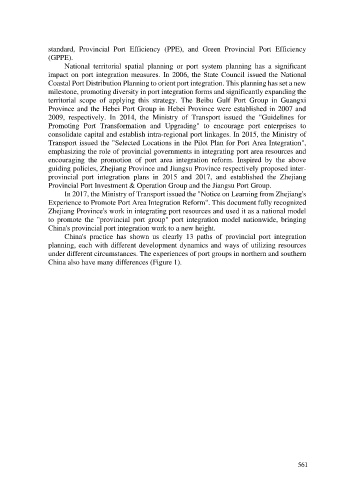Page 569 - Ebook HTKH 2024
P. 569
standard, Provincial Port Efficiency (PPE), and Green Provincial Port Efficiency
(GPPE).
National territorial spatial planning or port system planning has a significant
impact on port integration measures. In 2006, the State Council issued the National
Coastal Port Distribution Planning to orient port integration. This planning has set a new
milestone, promoting diversity in port integration forms and significantly expanding the
territorial scope of applying this strategy. The Beibu Gulf Port Group in Guangxi
Province and the Hebei Port Group in Hebei Province were established in 2007 and
2009, respectively. In 2014, the Ministry of Transport issued the "Guidelines for
Promoting Port Transformation and Upgrading" to encourage port enterprises to
consolidate capital and establish intra-regional port linkages. In 2015, the Ministry of
Transport issued the "Selected Locations in the Pilot Plan for Port Area Integration",
emphasizing the role of provincial governments in integrating port area resources and
encouraging the promotion of port area integration reform. Inspired by the above
guiding policies, Zhejiang Province and Jiangsu Province respectively proposed inter-
provincial port integration plans in 2015 and 2017, and established the Zhejiang
Provincial Port Investment & Operation Group and the Jiangsu Port Group.
In 2017, the Ministry of Transport issued the "Notice on Learning from Zhejiang's
Experience to Promote Port Area Integration Reform". This document fully recognized
Zhejiang Province's work in integrating port resources and used it as a national model
to promote the "provincial port group" port integration model nationwide, bringing
China's provincial port integration work to a new height.
China's practice has shown us clearly 13 paths of provincial port integration
planning, each with different development dynamics and ways of utilizing resources
under different circumstances. The experiences of port groups in northern and southern
China also have many differences (Figure 1).
561

